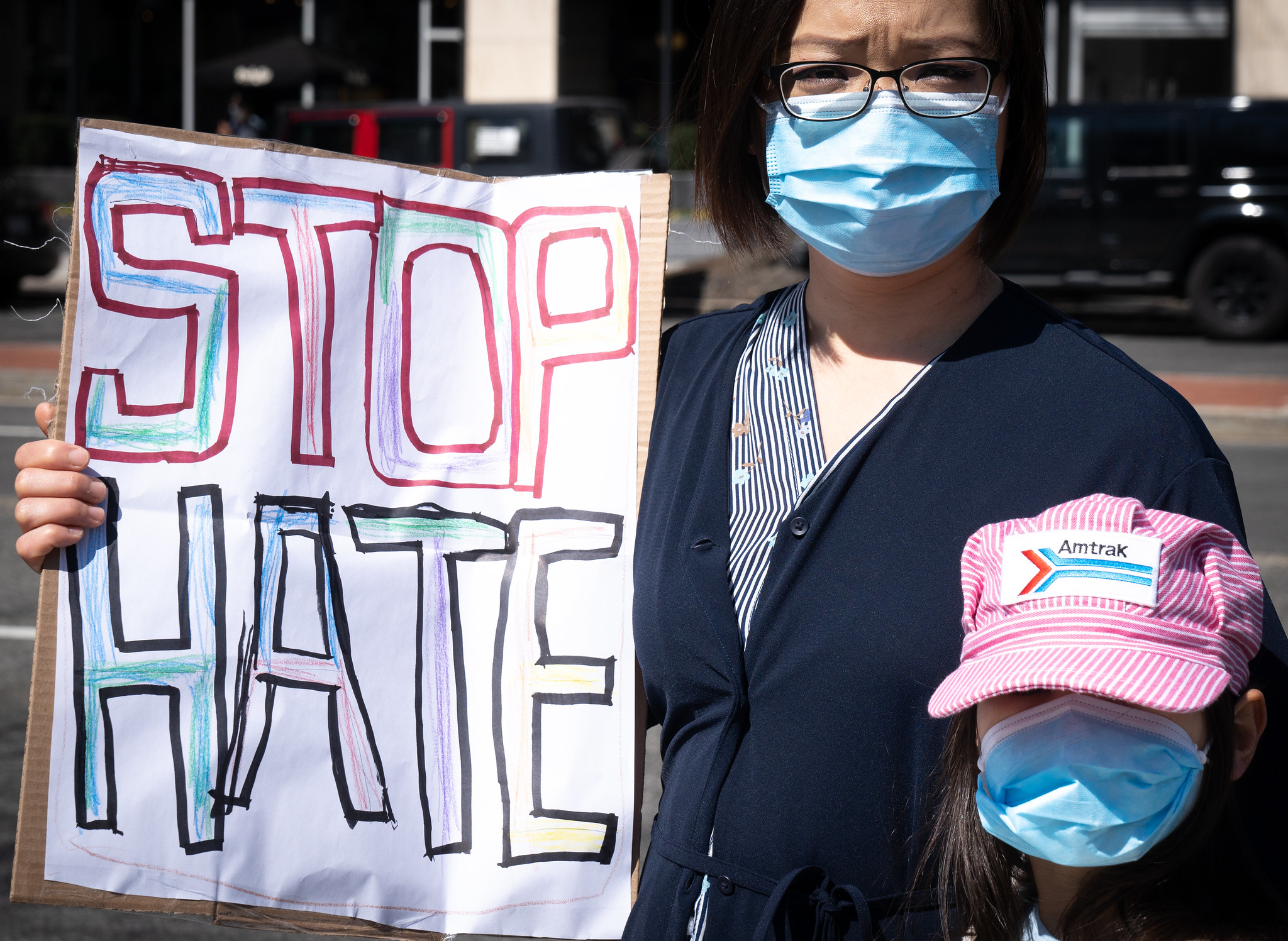Why There’s Not Much Data on Anti-Asian Violence
The FBI’s hate crimes data is better than nothing, but the numbers produced by the bureau each year are not particularly useful.

Published by The Lawfare Institute
in Cooperation With

The murder of eight people in Atlanta on March 16, including six Asian women, has brought the issue of an apparent rise in hate crimes against Asians and Asian Americans into the national spotlight. Earlier this month, Congress reintroduced the COVID-19 Hate Crimes Act, which calls on the Department of Justice to review anti-Asian hate crimes related to the coronavirus pandemic and improve hate crimes reporting. President Biden has called on Congress to pass this legislation swiftly. The call for improved study of hate crimes gets to an important fact: Even as hate crimes against Asians and Asian Americans seem to be increasing, little data is available to accurately keep track of these crimes.
There is some evidence that anti-Asian hate crimes increased in 2020, though national data won’t be fully available for another six months. New York City is one of a handful of cities that publish hate crimes open data. Comparing 2020 to previous years shows there were as many anti-Asian hate crimes in March and April 2020 as in the previous four years combined (Figure 1). The elevated trend appears to have continued through much of the rest of 2020.
Figure 1. Anti-Asian hate crimes reported in New York City.
Yet data on hate crimes is scarce—and incomplete. Consider the story shared by former University of North Carolina basketball player Kane Ma. After the Atlanta shooting, Ma felt compelled to discuss a racially motivated assault in Chapel Hill, North Carolina, that sent him to the hospital in 2019. A review of incident-level hate crimes data from 2019, however, shows no such incident was reported by the FBI. This could be because it was not reported to the police, or because the police did not record it as a hate crime.
Either way, the failure to record the attack on Ma underlines the challenges of using hate crimes data to determine changing hate crimes trends in the United States. Simply put: The data is not very good.
The best source of data on hate crimes in the United States comes from the FBI’s collection. Under the Hate Crimes Statistics Act of 1990, the attorney general is required to collect and report each year on “crimes that manifest evidence of prejudice based on race, gender and gender identity, religion, disability, sexual orientation, or ethnicity.” Individual agencies collect data on hate crimes and report them to the FBI, which has published a report each year since 1992.
It’s tempting to use the FBI’s data to evaluate national hate crimes trends. But this data is fraught with problems that make analyzing hate crimes trends mostly impossible. The FBI’s data is certainly better than nothing, but the numbers produced by the bureau each year are not particularly useful for several reasons.
To begin with, hate crimes data reported by the FBI does not attempt to account for agencies that did not report or reported incomplete data. As a result, national hate crimes data is better thought of as a floor, rather than an accurate figure to be cited authoritatively.
The FBI reports annual national crime statistics through the Uniform Crime Report. But not all agencies send in a full year of data every year, so the FBI takes data from the majority of agencies with complete data and estimates counts from the agencies that either did not report or reported incomplete data to build a national estimate of major crimes each year. With hate crimes, by contrast, the FBI simply reports the number of crimes reported as the total number of hate crimes. As a result, national hate crimes statistics often just reflect how many agencies complied with guidelines to report such incidents. Without a true estimate of hate crimes, it is largely impossible to say whether an increase in reported hate crimes nationally indicates that more crimes occurred, or if agencies simply did a better job reporting incidents.
What’s more, national hate crimes data is impossibly delayed. Regular crime data is reported at the end of September of the following year—but hate crimes data is released even later, in mid-November. So, if you want to even hazard a guess as to whether anti-Asian hate crimes increased nationally in March 2020, around when the coronavirus pandemic arrived in much of the United States, you will have to wait until November 2021 to access that flawed data.
Another major challenge with hate crimes data is that collection depends on local law enforcement agencies. In 2019, the FBI touted 15,588 law enforcement agencies across the country that participated in the hate crimes program—but far fewer agencies report data each year. As the Anti-Defamation League writes, “[T]he FBI’s report is based on voluntary local law enforcement reporting to the Bureau. In 2019, 86 percent of participating agencies didn’t report a single hate crime to the FBI, including at least 71 cities with populations over 100,000. Just over 2,000, or 14 percent, of the more than 15,000 participating agencies actively reported at least one hate crime.”
The FBI has detailed definitions of what constitutes regular offenses like aggravated assault and theft, but hate crimes are largely up to the states to define as they see best. And what gets reported as a hate crime is often up to the discretion of individual agencies. The bureau acknowledges the difficulty in ascertaining whether a reported incident is a hate crime, telling agencies that “bias is to be reported only if investigation reveals sufficient objective facts to lead a reasonable and prudent person to conclude that the offender’s actions were motivated, in whole or in part, by bias” (emphasis added).
Adding to the challenge, not all states require law enforcement to collect data on hate crimes. According to the Department of Justice, 30 states have hate crimes laws that require data collection, 17 states have hate crimes laws that do not require data collection, and three states (Arkansas, South Carolina and Wyoming) have no hate crimes laws at all. The result is wildly inconsistent hate crimes reporting from state to state and year to year. Alabama, for example, has reported no hate crimes in five of the past 20 years and reported seven hate crimes in 2018 and 2019 combined. Similarly, Mississippi and Wyoming have reported five or fewer hate crimes in 13 and 14 of the past 20 years, respectively. Only two agencies per year reported hate crimes in Mississippi on average each year since 2000—while more than 150 agencies in both Michigan and New Jersey reported at least one hate crime on average each year over that span.
Digging deeper into hate crimes data from Arkansas—a state with no hate crimes laws—highlights the scope of the problem.
Nationally, 10 percent of hate crimes reported to the FBI have been deemed “anti-White” over the past 20 years—but anti-White hate crimes made up 33 percent of hate crimes reported in Arkansas over that time span, including 45 percent of the state’s hate crimes reported between 2003 and 2006. Just in 2003, anti-White hate crimes made up 55 percent of all hate crimes reported in Arkansas, compared to 11.5 percent nationwide. The tiny city of Waldron (population 3,618 in 2010) reported 38 anti-White hate crimes in 2003—which accounted for 4.5 percent of all anti-White hate crimes reported nationwide that year and nearly as many as the 41 reported by Los Angeles and New York City combined. Presumably, this is not because Waldron—a town that, as of 2010, was 90 percent white—is a national capital of anti-White racial hatred. It probably speaks more to the reporting practices of local Waldron law enforcement.
The problem of nonstandardized reporting practices persists with respect to sexual orientation hate crimes, too. Out of reported hate crimes committed on the basis of sexual orientation since 2000, less than 2 percent have been “anti-heterosexual.” But 16.3 percent of sexual orientation hate crimes in Arkansas over that span were anti-heterosexual. Nearly 40 percent of all anti-heterosexual hate crimes reported nationally in 2008 came from either Craighead County, Arkansas (population 96,744 in 2010) or the city of Flint, Michigan (population 102,266 in 2010). It seems unlikely that two regions of the country with a relatively low population are responsible for such a disproportionate number of hate crimes against straight people.
Hate crimes data must also contend with the fact that communities victimized by hate crimes may be less likely to report to the police. As CNN’s Priya Krishnakumar writes, “[L]ongstanding distrust of law enforcement, language barriers and immigration status” are all reasons why people might be deterred from reporting hate crimes. Likewise, a 1997 guide to hate crimes from the Department of Justice highlights myriad other reasons why victims of hate crimes may be hesitant to come forward. Victims may fear being outed or stigmatized, or they may want to “avoid the humiliation of recounting the event.”
Hate crimes are also underreported because the types of crimes that tend to be hate crimes are generally less likely to be reported to the police. More than 20 percent of hate crimes reported since 2010 have been simple assaults—defined by the FBI as “assaults that do not involve the use of a firearm, knife or cutting instrument, or other dangerous weapon, and in which the victim did not sustain serious or aggravated injuries are reported as other assaults”—which are substantially less likely to be reported to the police than aggravated assaults, involving a weapon or serious injury. In 2018, the National Crime Victimization Survey estimated that 61 percent of aggravated assaults were reported to the police while just 38 percent of simple assaults were reported.
Analyzing incident-level hate crimes data can show a few larger trends—as the above analysis of anti-Asian hate crimes in New York City shows. For example, there were more reports of anti-Islam and anti-Arab hate crimes in September and October 2001 than in the previous 10 years combined (Figure 2). There also was a smaller spike in reported anti-Islam and anti-Arab hate crimes beginning in December 2015, the month in which former President Trump called for a “total and complete shutdown of Muslims entering the United States.”
Figure 2. Anti-Islam and anti-Arab hate crimes reported in New York City.
Anti-Islam and anti-Arab hate crimes remained elevated through 2019, though it is difficult to say to what degree this was due to improved reporting practices by police, more hate crimes occurring, or both.
Whether you are building a baseball team, combating a pandemic, or responding to a surge in hate crimes, a prerequisite to effective problem-solving is accurate, comprehensive and timely data. National hate crimes data should be able to reliably show what types of hate crimes are rising or falling and where, and a reporting system should not require waiting 8 months to figure out what happened in March of last year. Having reliable data makes it possible for policymakers to be confident that they are addressing an emerging issue and allows researchers to evaluate the effectiveness of policy responses.
There is plenty of anecdotal evidence showing increasing hate crimes in the United States targeting the Asian community. Better and faster reporting of hate crimes data, including standardized reporting practices, could be an important tool in combating this terrible trend. Unfortunately, the nation’s hate crimes data collection system is not set up to rapidly and accurately identify the when, where, and why of rising hate crimes to better help the U.S. solve this problem.


.png?sfvrsn=48e6afb0_5)


